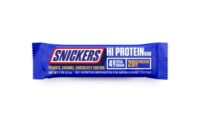
By Carla Zanetos Scully
As the category
continues to grow, sugar-free non-chocolate candy companies are coming out with
new and different types of products to compete with increased demand. Unit sales jumped 6% from a year ago while
dollar sales gained nearly 8% during the same time frame, reports Chicago-based
Symphony IRI.
To “shake up the
category” Sorbee International introduced Crystal
Light Chewy Candy in strawberry, lemon, orange and raspberry flavors. This
square chewy candy, offering one-third fewer calories with Splenda as its sweetener, comes in a 3.3-oz. peg bag and is
reminiscent of what a sugar-free Starburst
might be like.
“When you look at
a typical sugar-free set, a lot of it is chocolate and hard candy,” says Dan
Werther, Sorbee’s ceo. “We loved the concept of a chewy sugar-free offering.”
He goes on to say
that retailers had been indicating that a chewy offering would draw other
segments of the population that aren’t normally attracted to sugar-free items.
Although the company was not trying to replicate Starburst, Werther says the Crystal
Light brand has a flavor profile that attracts customers that otherwise
might not think sugar-free candy tastes good. He’s optimistic that his company
and others will create more innovative products to enhance the category.
“Our business is
up 40% from last year because we pushed the Crystal
Light products,”
Werther says. Moreover, he wonders how the category as a whole could do if only
movie theaters and convenience stores would start offering sugar-free items as
well. If it would be offered, he says, “People will see it and buy it.”
“In the past,
sugar-free candy was perceived as a group of products that was only for people
who were either diabetic or on a very strict low-carb diet,” says Ben Jones,
associate marketing manager for Storck, USA.
“Now that mainstream consumers are also discovering how great many of the
sugar-free candy products are, they realize this is a great way to cut out
sugar and calories from their diet, even if they are not on a strict diet or do
not need to limit their blood sugar for medical reasons.”
Storck’s Werther’s Original Sugar Free has come
out with a few new products in recent years. Caramel Cinnamon was launched this
past year and has received “excellent” consumer feedback, adds Jones. It was
added to the family that includes Caramel Coffee and Caramel Mint. All are made
with isomalt, a sugar alcohol, and acesulfame-K, a high-intensity sweetener.

To attract a younger audience, Eda’s Sugarfree Candies in Philadelphia has created a new mix of flavors. The 6-ounce Carnival Mix contains bubblegum, cotton candy, marshmallow, caramel, red licorice, black licorice, popcorn and root beer flavors, with marshmallow, cotton candy, bubblegum and caramel all new flavors.
President Brian Berry says the new mix began distribution in August and is getting reorders, suggesting the launch has struck a chord. “We are expanding our range of flavors while others are contracting or eliminating flavors,” he says.
Businesswise, Berry says there’s a lot of pressure to reduce the variety of items on grocery store shelves. “We’re in a unique situation,” he adds. Instead of eliminating products that don’t seem to have room on the shelves, Eda’s is putting together mixes. Three of the five mixes offered, he says, have 10 flavors. “We can broaden our audience by increasing the range of flavors.”
“We believe (the increase in sugar-free sales) is due to demographics and consumer health concerns,” says Matthew Fenton, vice president of marketing for Farley’s & Sathers Candy Co., of Round Lake, Minn. “However, it also indicates that manufacturers are doing a better job creating products that deliver. Candy is a pleasure product, and sugar-free consumers don’t want to sacrifice taste or performance – nor should they have to.”
Farley’s & Sathers just launched Brach’s Sugar Free Lemon Drops, a sugar-free version of its classic Lemon Drops. This joins a lineup of sugar-free products that includes Cinnamon, Butterscotch and Star Brites Peppermint hard candies. “More than most brands, Brach’s has multi-generational appeal, and this sugar-free lineup satisfies both older consumers and those seeking to reduce the amount of sugar in their diets,” Fenton adds.
He expects sustained growth in the sugar-free segment. “Manufacturers have improved quality of the products in this segment, and consumers have responded,” Fenton adds. “Meanwhile, retailers are dedicating space and promotional attention to these products in many categories and some are even launching in-store diabetic initiatives.”
Just Born Inc., of Bethlehem, Pa., added Peeps Sugar-Free Peppermint Flavored Marshmallow Stars as part of its holiday lineup this past Christmas season, reflecting its plan to add sugar-free seasonal items, such as Sugar-Free Hearts for Valentine’s Day, Sugar-Free Chicks for Easter, and Sugar-Free Pumpkins for Halloween. Sweetened with Splenda, the Stars can be added to hot beverages or recipes and are available in three-count packages.
Flavor expansion continues within the sugar-free hard candy segment as well. For example, Hillside Candy, of Hillside, N.J., touts its tropical fruit collection of peach, mango, strawberry kiwi, passion fruit and pina colada, under the Golightly Sugar Free Candy brand, a line that has done well in the marketplace, says Susan Rosenthal-Jay, vice president of marketing and exports for the Hillside, N.J.-based company.
Hillside offers 13 different peg bags and about two dozen bulk flavors, as well as private labeling. “We can produce just about any flavor any company may want,” she adds.
David Bryan, of Columbus, Ohio, and owner of eight online
retails sites, including DiabeticFriendly.Com, says many of his customers are
seeking sugar-free ingredients that don’t “cause diuretic effects like most of
the older stuff does. Reducing the adverse laxative effect is the No. 1 thing.”
“(Customers) are
looking for no sorbitol or maltitol, which can give that effect,” Bryan continues. He goes
on to say the major chocolate companies still use maltitol.
Bryan also points that the use of stevia as a
sweetener remains limited, noting only four of his 35 cakes mixes use the
ingredient. Although switching over to using stevia has appeal, because of its
all-natural claim, the added costs in development, labeling and packaging for
manufacturers who are already using different sweeteners remains a major
consideration by confectioners today.
This is why the
online retailer has 1,400 sugar-free items including about 300 different hard
candies. “We want to provide customers with what they want,” Bryan
says. “Brand loyalty is brand loyalty. At the end of the day, no one (sugar
substitute) is dominant.”
Jones concurs, it’s
all about the brand, he says. Customers are ot seeking out any specific sugar
substitute, h explains. Rather, they are purchasing sugar-free products based
on taste not specific ingredients.
“(Customers) know which brands and flavors they have tried
in the past and they go back to those that taste the best,” Jones adds. “Most
sugar-free candy consumers have tried multiple brands and have formed their
opinions about them.”



